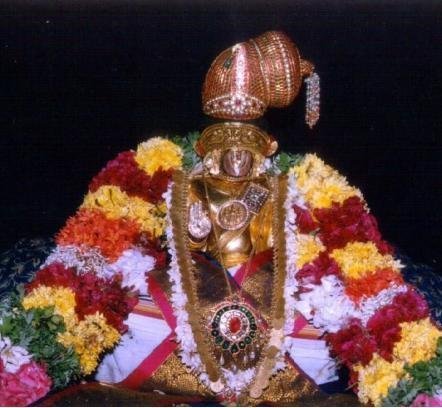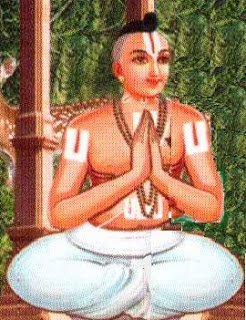SrI: SrImathE SatakOpAya nama: SrImathE rAmAnujAya nama: SrImadh varavaramunayE nama:
Let us continue with the third and concluding part of the avathArikai (introduction). In this section of the introduction, mAmunigaL explains that this SrIvachana bhUshaNam is explaining dhvaya mahA manthram in detail as it is done in thiruvAimozhi.
Similar to thiruvAimozhi which is known as dhIrga SaraNAgathi (deep surrender), this prabhandham is an explanation of dhvayam. In thiruvAimozhi, dhvayam is explained in detail as follows:
- In the first 3 centums (1 – 3), the second part of dhvayam (upEyam – goal) is explained in detail.
- In the next 3 centums (4 – 6), the first part of dhvayam (upAyam – means) is explained in detail.
- In the next 4 centums, the following principles are explained in detail:
- the auspicious qualities of bhagavAn which are required in him to bless everyone
- nammAzhwAr‘s total detachment towards AthmA (self) and those which are related to AthmA such as body, senses, etc.
- the eternal relationship between himself (nammAzhwAr) and emperumAn
- nammAzhwAr recollecting the accomplishment of ultimate goal
Similarly, in this SrIvachana bhUshaNam also, the same principles are explained:
Considering the 6 prakaraNams (sections) classification:
- First part of dhvayam is explained in the first 3 prakaraNams:
- First srI mAhAlakshmi‘s purushakAram (advocacy/recommendation) is explained
- bhagavAn as the upAyam (means) is explained
- The nishtai (state) of the ones who accept bhagavAn as upAyam (goal)
- Second part of dhvayam is explained while explaining the desirable state of the ones who want to fully engage in bhagavath kainkaryam only.
- In the remaining 3 prakaraNams,
- 4th prakaraNam explains the Sishya’s attitude and servitude towards AchArya who explains the dhvaya mahA manthram
- 5th prakaraNam explains bhagavAn‘s nirhEthuka krupai (causeless mercy) which is the cause of the Sishya’s mahA viSvAsam (total dependence)
- 6th prakaraNam explains the ultimate state of the principles explained in the two parts of the dhvaya mahA manthram (upAyam and upEyam) – that is total dependence on AchAryan.
Considering the 9 prakaraNams (sections) classification:
“prapadhyE” in first sentence of dhvayam reflects the act of accepting bhagavAn as the means and this implicitly means that other upAyams such as karma, gyAna, bhakthi yOgams etc are given up fully. prapanna dhinacharyA (daily routine, attitude, behaviour of a prapanna) is meant for such persons who have performed prapaththi. And a true AchArya means the one who instructs/explains dhvaya mahA manthram. Thus, from all of the above, it can be understood that in the 9 prakaraNam classification also, thiruvAimozhi (dhvaya mahA manthram’s explanation) and SrIvachana bhUshaNam explain the same principles.
Further, this prabhandham which mainly explains the dhvaya mahA manthram in detail, also contains the principles which are explained in thirumanthram and charama SlOkam. Let us see these now:
First thirumanthram explanation is highlighted.
- From (sUthram 73) “ahamarththaththukku” up to (sUthram 77) “adiyAnenRiRE” and as said in (sUthram 111) “svarUpa prayukthamAna dhAsyamiRE pradhAnam”, “praNavam” is explained.
- From (sUthram 71) “svayathna nivruththi” and from (sUthram 180) “thannaith thAnE mudikkaiyAvadhu” up to the sUthram before (sUthram 243) “ippadi sarva prakAraththAlum”, “nama:” is explained.
- From (sUthram 72) “paraprayOjana pravruththi” and from (sUthram 80) “upEyaththukku iLaiya perumALaiyum” and from (sUthram 281) “kainkaryandhAn bhakthi mUlam allAdha pOdhu” , “nArAyaNAya” is explained.
Next charama SlOkam explanation is highlighted.
- From (sUthram 43) “agyAnaththAlE” and from (sUthram 115) “prApakAnthara parithyAgaththukkum” giving up all other upAyams and the method to give them up are explained. This explains “sarvadharmAn parithyajya“.
- From (sUthram 55) “idhu thanakku svarUpam” and from (sUthram 66) “prApthikku upAyam avan ninaivu” that bhagavAn is the only refuge and means is explained. This explains “mAmEkam SaraNam“.
- From (sUthram 134) “prapaththi upAyaththukku” the special nature of the act of surrender is explained. This explains “vraja“.
- From (sUthram 143) “avanivanai” (அவனிவனை) up to (sUthram 148) “svAthanthriyaththAlE varum pArathanthriyam prabalam” that bhagavAn is supremely independent and that he easily pardons all sins of the surrendered jIvAthmA are explained. This explains “aham thvA sarva pApEbyO mOkshyishyAmi“.
- (sUthram 402) “krupA palamum anubaviththE aRavENum” explains that bhagavAn‘s mercy is guaranteed to bestow the ultimate goal and that the jIvAthmA need not worry about. This explains “mA Sucha:“.
Thus we have seen the section in the glorious introduction by mAmunigaL for piLLai lOkAchAryar‘s SrIvachana bhUshaNam where the similarity between thiruvAimozhi and SrIvachana bhUshaNam, and the SrIvachana bhUshaNam reflecting the principles of rahasya thrayam are explained in detail.
Thus ends mAmunigaL‘s introduction to piLLai lOkAchAryar‘s SrIvachana bhUshaNa dhivya SAsthram. As mAmunigaL declares in upadhEsa raththina mAlai, there is no grantham which is as glorious as this SrIvachana bhUshaNa dhivya SAsthram.
The following pAsurams are usually recited after reciting SrIvachana bhUshaNa dhivya SAsthram.
kOdhil ulagAsiriyan kUra kulOththama thAdhar
thIdhil thirumalaiyAzhwAr sezhunguravai maNavALar
Odhariya pugazhth thirunAvudaiya pirAn thAdharudan
pOdha maNavALa muni ponnadigaL pORRuvanE
Simple translation: I glorify the lotus feet of the most knowledgeable maNavALa mAmunigaL along with the blemishless piLLai lOkAchArayar, kUra kulOthuma dhAsar, the defectless thirumalai AzhwAr (thiruvAimozhip piLLai), azhagiya maNavALap perumAL piLLai (mAmunigaL’s maternal grand father) from kuravai clan, the boundlessly famous thirunAvIrudaiya pirAn thAdharaNNar (mAmunigaL’s father).
vAzhi ulagAsiriyan vAzhi avan mannu kulam
vAzhi mudumbai ennum mAnagaram
vAzhi manam sUzhndha pErinbam migu nallAr
inam sUzhndhu irukkum iruppu
Simple translation: Hail piLLai lOkAchAryar! Hail his glorious clan! Hail the great city mudumbai (native town of his clan)! Hail that blissful assembly of piLLai lOkAchAryar who is surrounded by the most pious devotees.
Odhum mudumbai ulagAsiriyan aruL
Edhum maRavAdha emperumAn nIdhi
vazhuvAch chiRunallUr mAmaRaiyOn pAdham
thozhuvArkku vArA thuyar
Simple translation: There are no sorrows for the ones who worship the lotus feet of kUra kulOththama dhAsar who hails from siRunallUr, who is well-learned in the great vEdham and who sincerely practices the principles of SAsthram and who constantly remembers the grace of piLLai lOkAchAryar.
adiyen sarathy ramanuja dasan
archived in https://granthams.koyil.org/
pramEyam (goal) – https://koyil.org
pramANam (scriptures) – https://granthams.koyil.org
pramAthA (preceptors) – https://acharyas.koyil.org
SrIvaishNava Education/Kids Portal – https://pillai.koyil.org




